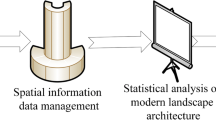Abstract
Urban gardens are based on gardens and modern gardens, and are closely related to urban development, so as to adapt to the needs of the city and the needs of each generation. It is a new type of garden for the purpose of mobilizing the entire urban area to achieve landscaping and building the country. Protecting the environment is one of the basic understandings and basic goals of long-term stable growth, but achieving sustainable growth is still a serious challenge. In the development of human society, the government plays two roles of protecting the environment and destroying the environment, and has an unavoidable environmental responsibility. Environmental protection is an important area where the government needs to play a central role at this stage. However, the focus of environmental protection is to protect soil microorganisms. Soil microorganisms are highly diversified and have a decisive impact on the ecosystem. They destroy organic matter in the soil and absorb inorganic nutrients, leading to nutrient cycling in the soil and affecting the growth and diversity of plants on the ground. The use of garden GIS systems for environmental protection will improve the manageability of each area, but due to the differences in each area, the design methods of these systems cannot meet the special needs of garden management. Therefore, we have further designed a garden GIS system that can satisfy the garden management system. The system aims to characterize these built gardens and can meet the daily management needs of most garden recorders. At the same time, it uses Web Service technology to pass the soil to protect the microorganisms and the garden environment.


















Similar content being viewed by others
Change history
06 December 2021
This article has been retracted. Please see the Retraction Notice for more detail: https://doi.org/10.1007/s12517-021-09166-w
28 September 2021
An Editorial Expression of Concern to this paper has been published: https://doi.org/10.1007/s12517-021-08471-8
References
Bi L, Xie W, Zhao JJ (2019) Automatic recognition and classification of multi-channel microseismic waveform based on DCNN and SVM. Comput Geosci 123:111–120. https://doi.org/10.1016/j.jappgeo.2018.09.022
Jia CZ (2007) Oil sand resources and evaluation methods of reserves. Petroleum Industry Press, Beijing (in Chinese)
Jin WH, Zhou W, Zhang YD, Yu L, Niu HL (2008) Mineralization factors of Baijiantan oil sand in northwest Junggar Basin. Spec Oil Gas Reserv 6(12-21):95 (in Chinese)
Kramers JW, Mcssop GD (1987) Geology and development of the Athabasca oil sand deposit. Can Min Metall Bull 69:92–99
Liu C (2013) The research on oil sand reservoir sedimentary microfacies and sandbody properties of Y2+3 on ZhenLai county in western slope of Songliao basin. Dissertation, Jilin University (in Chinese)
Luo HH (2013) The reservoir forming main control factors and distribution law of the Upper Cretaceous slope migration type oil sands in Songliao Basin. Dissertation, Jilin University (in Chinese)
Murnion DS (1996) Comparison of back propagation and binary diamond neural networks in the classification of a Landsat TM image. Comput Geosci 22:995–1001. https://doi.org/10.1016/S0098-3004(96)00037-4
Rumelhart DE, Hinton GE, McClelland JL (1986) A general framework for parallel distribution processing. In: Rumelhart DE, McClelland JL (eds) Parallel distribution processing, vol 1. MIT Press, Cambridge
Shan XL, Che CB, Li J, Fan YC, Zang CY, Wang QB (2007) Present status of oil sand resources at home and abroad. Glob Geol 4:459–464 (in Chinese)
Shi BB, Chang XC, Yin W, Li Y, Mao LX (2019) Quantitative evaluation model of tight sandstone reservoirs based on statistical methods - a case study of the Triassic Chang 8 tight sandstones, Zhenjing area, Ordos Basin, China. J Pet Sci Eng 173:601–616. https://doi.org/10.1016/j.petrol.2018.10.035
Suwansawat S, Einstein HH (2006) Artificial neural networks for predicting the maximum surface settlement caused by EPB shield tunneling. Tunn Undergr Space Technol 21:133–150. https://doi.org/10.1016/j.tust.2005.06.007
Wang ZD, Wang XH, Zhang W, Yang XM, Ping Y (2008) BP neural network model to recognize carbonate reservoir in Tazhong of Tarim Oilfield. J Oil Fas Technol 2:25 + 279–25 + 281 (in Chinese)
Xue LF, Pan BZ (1999) Identify lithofacies automatically using self-organizing neural network. J Changchun Univ Sci Technol 29:144–147 (in Chinese)
Yan B, Zhang QH, Wai Onyx WH (2008) Prediction of sand ripple geometry under waves using an artificial neural network. Comput Geosci 34:1655–1664. https://doi.org/10.1016/j.cageo.2008.03.002
Yang WF, Xia XH (2013) Prediction of mining subsidence under thin bedrocks and thick unconsolidated layers based on field measurement and artificial neural networks. Comput Geosci 52:199–203. https://doi.org/10.1016/j.cageo.2012.10.017
Yang H, Huang JQ, Hu XT, Shi MY (2013) Application of BP neural net in lithologic identification of tight sandstone gas reservoirs. Pet Geophys 1:39–42 (in Chinese)
Yin GZ, Li MH, Li WP, Cao J (2013) Model of coal gas permeability prediction based on improved bp neural network. J China Coal Soc 7:1179–1184
Zhang T (2010) Application of BP neural network in logging interpretation. Dissertation, Northwest University (in Chinese)
Zhang H, Zou LJ, Shen XH (2002) The application of BP neural network in well lithology identification. Geol Prospect 6:63–65 (in Chinese)
Zhang JL, Liu SS, Li JZ, Liu LL, Liu HM, Sun ZQ (2017) Identification of sedimentary facies with well logs: an indirect approach with multinomial logistic regression and artificial neural network. Arab J Geosci 10:247. https://doi.org/10.1007/s12517-017-3045-6
Author information
Authors and Affiliations
Corresponding author
Ethics declarations
Conflict of interest
The authors declare that they have no competing interests.
Additional information
Responsible Editor: Sheldon Williamson
This article is part of the Topical Collection on Environment and Low Carbon Transportation
This article has been retracted. Please see the retraction notice for more detail: https://doi.org/10.1007/s12517-021-09166-w
About this article
Cite this article
Yu, L., Xie, X. & Wei, L. RETRACTED ARTICLE: Green urban garden landscape design and soil microbial environmental protection based on Virtual Visualization System. Arab J Geosci 14, 1155 (2021). https://doi.org/10.1007/s12517-021-07485-6
Received:
Accepted:
Published:
DOI: https://doi.org/10.1007/s12517-021-07485-6




